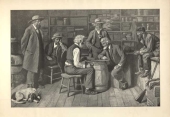The Checker Maven
The World's Most Widely Read Checkers and Draughts Publication
Bob Newell, Editor-in-Chief
Published every Saturday morning in Honolulu, Hawai`i
Noticing missing images? An explanation is here.
Mitchell's Miracle

This month we present Mitchell's Miracle, the second part of The Champion's Choice, which we began in last month's Tricks Traps & Shots of the Checkerboard installment. Please see there for the run-up to Variation 2, which begins from the diagram just below. Willie Ryan is here to tell us more. It can be a little confusing, so if you get lost, just go down to the bottom of this article to see the problem diagram.
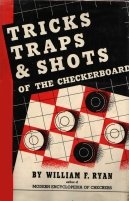
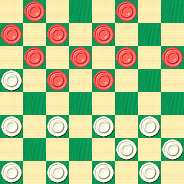
WHITE
White to Play
W:W32,31,30,29,28,27,24,23,22,21,13:B15,14,12,11,10,9,7,6,5,3,1.
Variation 2
| 23-19---A | 23-14 | 30-23 | 20-16 | 11-7 |
| 14-17 | 9-25 | 9-14 | 17-22 | 31-26 |
| 21-14 | 29-22 | 23-19 | 15-11 | 7-2; |
| 10-26 | 12-16 | 15-24 | 22-26 | drawn. |
| 19-10* | 24-20 | 28-19 | 16-12 | Wm. F. |
| 7-14 | 16-19 | 1-5---C | 26-31 | Ryan. |
| 31-22* | 32-27 | 19-15 | 18-15 | |
| 11-15 | 5-9 | 14-17 | 9-14 | |
| 27-23* | 27-23 | 22-18 | 12-8 | |
| 14-18 | 19-26 | 5-9 | 3-12 |
A---The best that white can hope for after this move is a problematical draw---1. If white attempts 31-26 here, then 14-18, 23-14, 9-25, 29-22, 11-16, 24-20, 16-19 will leave black with a winning game. Another plausible try at A is 22-17. Black's strongest reply to this move is 14-18, 23-14, 9-18, which leaves white confronted with the critical situation shown on the diagram. I published play on this position a few years ago, claiming a black win against any defense adopted by white, but a problematical draw was found as follows. (See solution---Ed.)
C---Black can prolong the game by forcing white into a bridge ending like this: 14-17, 22-18, 17-22, 18-14, 22-26, 14-9, 6-10, 9-6, 10-14, 6-2, 14-17, 13-9, 17-21 (to stop the pitch by 9-6 next), 19-15, 26-31, 15-10, 31-26, 2-7, 26-22, 9-6, 22-18, and white having the move, can draw the ending."
1---The computer finds this move to be about as good as 23-18---Ed.
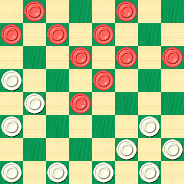
WHITE
White to Play and Draw
W:W32,31,30,29,28,27,24,21,17,13:B18,15,12,11,10,7,6,5,3,1.
This one is not easy, though we won't go so far to say that it would be a miracle if you solve it. No doubt some of you will work it out; you're a rather astute group, after all. Do try it and then click on Read More to enjoy the truly miraculous solution.![]()
The Champions' Choice
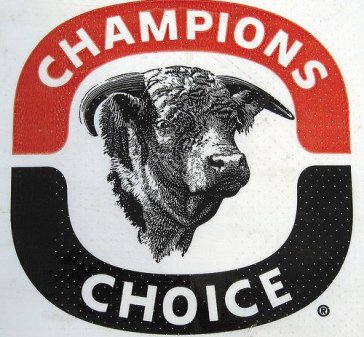
The photo above apparently advertises for something called "The Champion's Choice Trace Mineral Salt Block." It's intended for livestock, not checker players, unless there are some checker-playing cows out there. Certainly, though, there are many checker-playing raisers of livestock, so the photo might just be relevant after all. Besides, "The Champion's Choice" is Willie Ryan's title for today's checker study.
As we've mentioned before, the last installments of Willie Ryan's Tricks Traps & Shots of the Checkerboard are pretty long and complex. We've broken today's study into two parts. We'll present the second part in our next regular installment.
The study looks at the Cross Choice opening and it's fascinating to say the least. Let's let Willie tell us more.

"The Cross Choice opening, formed by 11-15, 23-18, 9-14, has long been a favorite battleground of the champions, and some of the most spectacular wins on the record have been scored on it. The following analytical study of this colorful debut bristles with brilliant play and unusual combinations:
| 11-15 | 17-13 | 7-10 |
| 23-18 | 2-6---C | 21-17*---F3 |
| 9-14 | 23-18*---D,2 | 16-19 |
| 18-11 | 14-23 | 29-25---G |
| 8-15 | 27-18 | 19-24---H |
| 22-17 | 10-14---E | 28-19 |
| 4-8 | 31-27*---F | 15-24 |
| 25-22 | 14-23 | 25-21* |
| 8-11---A,1 | 27-18 | 3-8---I, |
| 26-23---B | 12-16---F1 | to the |
| 6-9 | 24-20---F2 | diagram |
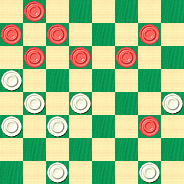
WHITE
White to Play and Draw
W:W32,30,22,21,20,18,17,13:B24,11,10,9,8,6,5,1.
A---7-11 is also good, as shown in Variation 1.
B---As played by Champions Rubin and Hunt. In view of the improved attack innovated at C, this 26-23 move will henceforth occupy a lower rating among the master minds. Probably the best move here for a draw is---B1: 17-13, 11-16, 22-17, 16-20 (16-19, 29-25, 7-11, 24-20, 2-7, 27-24, may be used as a plausible alternative), 26-23, 7-11, 29-25, 3-7, 24-19 (23-19, 5-9, 25-22, 14-18, 17-14, 18-25, 14-5, 25-29, 21-17, 11-16, 17-14, 16-23, 27-11, 20-27, 32-23, 7-16, 14-7, 2-11, 31-26, 11-15, 23-19, etc. produces the draw), 15-24, 28-19, 11-15, 32-28, 15-24, 28-19, 7-11, 31-26*, 11-15, 19-16, 12-19, 23-16, 15-19, 26-23, 19-26, 30-23, 10-15, 17-10, 15-19,10-7, 19-26, 27-23, 2-11, 16-7, 26-31, 23-19, 31-26, 19-16, 26-23, 25-22. Sam Levy, Manchester, England, 1937.
B1---The computer thinks 7-11 and 8-11 are about equally good and finds 17-13 to be a lesser choice---Ed.
C---Inaugurates a baffling attack, suggested to me by John T. Bradford. It improves upon the combination of: 14-17, 13-6, 17-26, 31-22, 2-9, 23-19 (used by Edwin F. Hunt, Nathan Rubin, and Asa Long in games played by them), which leaves black with a draw at best and no chance of winning. This 2-6 puts muscle in the black build-up and promptly takes the snapper out of white's formation. If black tries 1-6 at C, then we have a familiar Denny development, strong for white, which runs its course like this to a draw: 1-6, 23-19, 14-17, 21-14, 9-25, 29-22, 5-9, 27-23, 9-14, 24-20, 15-24, 28-19, 14-17, 31-26, 11-15, 32-28, 15-24, 28-19, 7-11, 22-18, 3-7,19-16,12-19,23-16, 6-9,13-6,2-9,16-12,17-21,12-8,10-15, 26-22, 7-10, 20-16, 11-20, 18-11, 10-15, 8-3, 15-19, 3-7, 19-23, 7-10, 23-27, 10-15, 20-24, 15-18, 9-13*, 11-7, 27-31, 7-2, 24-28, 2-7, 28-32, 7-10, 31-27. Wm. F. Ryan vs. Jesse B. Hanson, 1927.
D---The key to the situation, cramping mobility of the black pieces on squares 1, 5, 6, and 9. A good draw by any other move is hard to find, and even the text must be followed through by the subtle touches at J. For play on 23-19 at this point, see Variation 2---an exposition in hairline draughts! Ed.'s note: Variation 2 will be published next month.
E---This press is obviously the only move to gain a draw. If 12-16 is played, 24-20 wins.
F---31-26, 14-23, 26-10, 7-14, 29-25, 12-16, 32-27 or 30-26, then 11-15 leaves white irreparably impaired.
F1---The end of the KingsRow opening book, with an equal evaluation---Ed.
F2---It takes some deep computer analysis to reveal that 32-27 is the best move here, though any Black edge is tiny indeed---Ed.
F3---Willie stars this move, but 32-27 also is good---Ed.
G---The shot by 17-14, 10-26, 30-7, 15-22, 7-2, 22-26, leaves black with much the better ending, though a win would be hard to prove. The strength of the black ending rests in ultimately relieving the four man tie-up of his pieces on 1, 5, 6, and 9. This is accomplished by crowning the piece on 22, returning the king to square 18, and then conditionally "slipping" 9-14, 2-9, 14-17, thus removing the white king on square 2 from play. On such "ideas" and tactical threats is the game of checkers based. The more knowledge a student acquires of these principles of play, and the more adept he is in knowing when and how to threaten with the proper plan for a particular setup, the greater is his skill. The proficient planner makes the player.
H---Or 19-23, 28-24 (better than 20-16, 11-20, 18-11, 9-14, 25-21, 5-9, black strong), 3-8, 20-16, 11-27, 18-4, 27-31, 4-8, 31-27, 8-11, 27-24, 11-8 will also reach a draw. Wm. F. Ryan.
I---24-28, 30-26, 3-8, 17-14, 10-17, 21-14, 8-12, 22-17, 11-15, 18-11, 9-18,11-7,18-22, 26-23, 22-26, 23-18, 26-30,18-14, 30-25, 7-2, 25-22, 2-9, 22-18, 32-27, 28-32, 27-23, 18-27, 9-6 produces the draw. Wm. F. Ryan.
J---The timely rescue for white.
Variation 1
| 7-11 | 22-17 | 10-17 | 25-22 | 11-16 |
| 29-25 | 3-7 | 21-14 | 12-16 | 2-7 |
| 12-16 | 31-27---A | 18-23 | 22-18 | 31-26; |
| 24-20 | 1-5---B | 20-16 | 16-19 | drawn. |
| 16-19 | 27-23 | 11-27 | 1-6 | Wm. F. |
| 27-24 | 14-18 | 28-24 | 2-9 | Ryan. |
| 5-9 | 23-14---C | 19-28 | 13-6 | |
| 17-13 | 9-18 | 26-1 | 7-11 | |
| 8-12 | 17-14 | 27-31 | 6-2 |
A---White dares not go 32-27, since he will be stung by 19-23. However, white can travel safely to a draw with: 26-23, 19-26, 30-23, 1-5 (nothing better), 23-19*, 11-16, 20-11, 7-23, 24-19, 15-24,28-19,14-18,17-14,10-17, 21-14,2-7,19-15,12-16,15-11, 6-10, 11-2, 10-17, 13-6, 17-21, 2-7, 21-30, 7-11, 16-20, 31-26. Wm. F. Ryan.
B---If the play goes 11-16, 20-11, 7-16, 27-23, the breakup by 15-18 will promote a draw; but if the move is 2-7, white will reply with 32-27*, and black's position is perilous.
C---Or 23-16, 12-19, 17-14, 10-17, 21-14, 18-23, 14-10, 7-14, 20-16, 11-27, 28-24, 19-28, 26-1, 27-31, 13-6, 2-9, 1-6, 9-13, 25-22, 14-17, 22-18, 17-22, 18-14, 13-17, 6-9, 17-21, 9-13, also ending in a draw. John T. Bradford."
Ed.'s Note: Variation 2 will appear in the next installment.
Here's the diagram once again.

WHITE
White to Play and Draw
W:W32,30,22,21,20,18,17,13:B24,11,10,9,8,6,5,1.
Can you make the champion's choices here and solve the problem? Will you be a champ or a chump? We think if you give it a good try, you're a champ no matter. When you've chosen your moves, click on Read More to see the solution.![]()
Famous Shots IV

This month brings the fourth entry in our Famous Shots series, taken from Ben Boland's Famous Positions in the Game of Checkers. As always, the challenge is to solve the shot, and, if you wish, identify the "shot" pictured above.
Here's the run-up:
11-15 21-17 9-13 25-21 8-11 17-14---A 10x17 21x14 6-10 22-17 13x22 26x17 15-18 24-20---B 2-6 28-24 4-8---C 29-25 11-15 30-26 6-9---D
A---30-25 is better; Black now gets a small but noticeable advantage.
B---23-19 is better. Black's advantage is now significant.
C---6-9 would retain the Black advantage. The game is now about even.
D---Loses. 15-19 was correct.
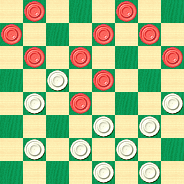
WHITE
White to Play and Win
W:W32,31,27,26,25,24,23,20,17,14:B18,15,12,10,9,8,7,5,3,1.
Aw, shoot; we're pretty much out of "shot" puns, so all we'll say is to see if you can solve it and then click on Read More to see the solution.![]()
Hobson's Choice
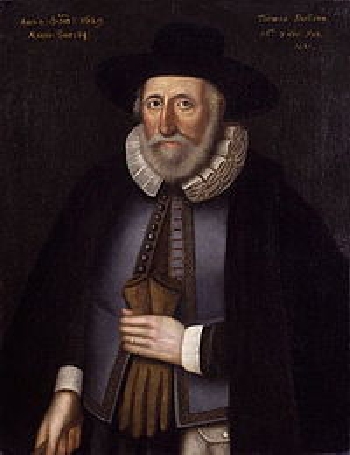
The phrase Hobson's Choice, named for 16th century English stable owner Thomas Hobson, is often used to describe a no-win situation. In checkers, that would occur when any move available would be bad; in other words, a player would be left to choose only among various losing options.
That usage, though frequently employed, is incorrect, as Hobson's Choice really means "take it or leave it"; you have but one option and there really is no choice except that of refusal. (Mr. Hobson reputedly offered his customers a choice of but one horse, which was no choice at all.) In checkers, however, you've got to make a move, so the phrase Hobson's Choice doesn't seem to apply.
We think, in the position below, as published by Ben Boland in Familiar Themes in the Scientific Game of Checkers, the author meant to use the term dilemma, which accurately refers to a choice among undesirable alternatives. Contrast this with Morton's Fork, which is a choice among equal or equivalent alternatives.
Confusing? Perhaps simply looking at the diagram is the best option.
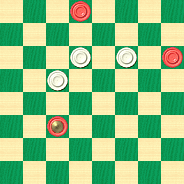
WHITE
White to Play and Draw
W:W14,11,10:BK22,12,2.
White indeed seems to face a dilemma; he's going to lose a man no matter what choices he makes. But a draw is still possible with perceptive play; can you find it?
Of course, for you, the reader, the choice is certainly Hobson's; you can choose to solve the problem, or just leave it! We do hope, though, that you'll try it, and then click on Read More to verify your solution.![]()
Famous Shots III

Checker School today brings us the third in our series of famous shots, taken from Ben Boland's Famous Positions in the Game of Checkers. As is the case with the other entries in this series, experienced players should recognize it by sight, while less experienced players would do well to learn the position.
Here's this week's run-up:
11-15 23-19 8-11 22-17 4-8 17-13 15-18 24-20 11-15 28-24 8-11 26-23 9-14 31-26 6-9 13x6 2x9 26-22 9-13---A
A---Loses. 3-8 or 1-6 would be correct. White to play and win.
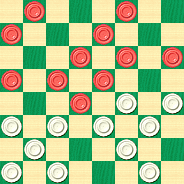
WHITE
White to Play and Win
W:W32,30,29,27,25,24,23,22,21,20,19:B18,15,14,13,12,11,10,7,5,3,1.
We're not sure which looks more interesting: the checker position or the attractive concoction shown in the photo at the top. Right now, though, let's go for the checker position. Find the solution, name the shot (both of them!), and then click on Read More to see the solution.![]()
Famous Shots II
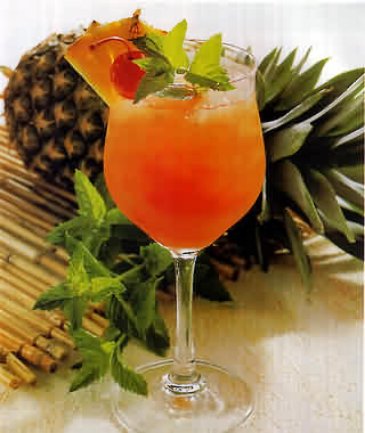
This month's Checker School column continues to feature famous shots. As we did last time, we ask you to not only solve the problem (figure out the shot) but also to identify the shot by name. These shots should be known by experienced players, and learned by aspiring ones.
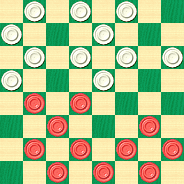
BLACK
Black to Play and Win.
B:W32,31,30,28,26,24,23,22,21,20,18:B16,15,11,9,8,7,6,5,3,2,1.
Do you know your shots? Try this one out and then click on Read More for the answers.![]()
Ferrie's Famous Five-Piece Freeze

We finally return to our republication of Willie Ryan's incomparable Tricks Traps & Shots of the Checkerboard; we're nearing the end of the book and Willie's examples have become long and complex. In fact, this month's installment is so complex we've decided to change the presentation format a little. On this page, we'll show you the problem diagram. On the Read More page, we've put the run-up and all the notes and variations.
Now, let's hear from Willie.

"Here is a star-studded study that I have prepared for my readers, to highlight what I consider the most sensational end-game win ever scored in crossboard competition:"
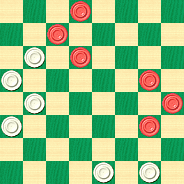
WHITE
White to Play and Win
W:W32,31,21,17,13,9:B24,20,16,10,6,2.
Don't be frozen out; chill a little, solve the problem, then click on Read More to thaw out the solution.![]()
Checker Friends the World Around

We are delighted to have, over the years, corresponded with readers from all over the world. The only place we haven't heard from is the Antarctic ... but we hope to hear from there someday, too.
Recently, one of our "checker friends"--- this gentleman is in Spain--- sent us a PDN file for W. T. Call's Midget Problems. You can download this file from the PDN page as linked in the right-hand column.
Mr. Call produced a number of books, not just on checkers, but Midget Problems is one of the best for the aspiring student of the art and science of checkers. Featuring small 2x2 settings, the book is a virtual classroom on this type of endgame.
Here's an example taken from the book.
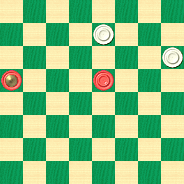
BLACK
Black to Play and Win
B:W26,21:BK20,18.
We know that miniatures are not everyone's cup of tea, but it's undeniable that a thorough knowledge of these positions is essential to checker mastery. So try this one out and then download the PDN file. It will serve you well.
When you're ready, click on Read More to see the solution.![]()
Clan M'Millan
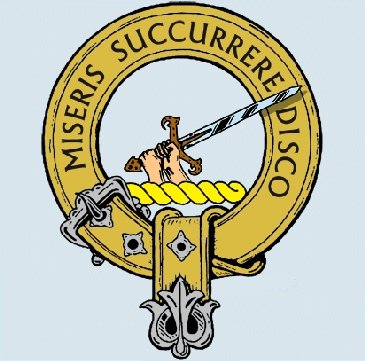
What's the reasoning behind the spelling "M'Millan"--- with an apostrophe? Why not spell out "McMillan" or "MacMillan"?
We found that question rather intriguing. We've seen the "M'Millan" variant before and never rightly understood it. But then again, we never really knew why some names are given as "MacMillan" and others as "McMillan."
The Clan MacMillan website set us straight.
It seems that the clan's name has two different spellings in the Scottish Gaelic language, both of them difficult to pronounce in English. There exists a variety of semi-phonetic transliterations. To avoid confusion, the "neutral" variant, "M'Millan," came into use. It's a clever and very clean solution..
Today's checker school problem, attributed to R. G. M'Millan, also offers a clever and clean solution. Can you find it?
BLACK
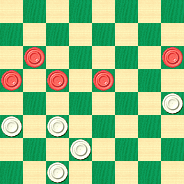
WHITE
White to Play and Win
W:W30,26,22,21,20:B15,14,13,12,9.
There should be no confusion here; the position is anything but neutral. After you've worked through it, click your mouse on Read More to see the apostrophic solution, notes, and a sample game.![]()
The Hand of D.E.O.
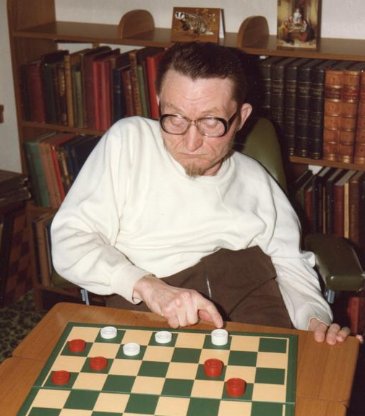
Someone who wishes to be known only as "A Checker Friend from Michigan" sent us a PDN file with all the positions from Derek E. Oldbury's 1947 book of problems, The Hand of D.E.O.. To say the least, this book is hard to find nowadays and if you haven't got a copy, go to the PDN link in the right column and download the file.
Mr. Oldbury's problems are interesting and practical. They aren't necessarily easy, of course, but we're sure you didn't expect a simple walk in the park. This is the man who famously said that he would "take the chances to make the chances" and never backed away from the challenge of pursuing of a win.
Here's an sample problem for you to try.
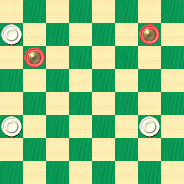
WHITE
White to Play and Win
W:W24,21,5:BK9,K8.
Take your chances and make your chances, then click on Read More to see the solution.![]()
The Checker Maven is produced at editorial offices in Honolulu, Hawai`i, as a completely non-commercial public service from which no income is obtained or sought. Original material is Copyright © 2004-2025 Avi Gobbler Publishing. Other material is public domain, AI generated, as attributed, or licensed under CC1, CC2,CC3 or CC4. Information presented on this site is offered as-is, at no cost, and bears no express or implied warranty as to accuracy or usability. You agree that you use such information entirely at your own risk. No liabilities of any kind under any legal theory whatsoever are accepted. The Checker Maven is dedicated to the memory of Mr. Bob Newell, Sr.

